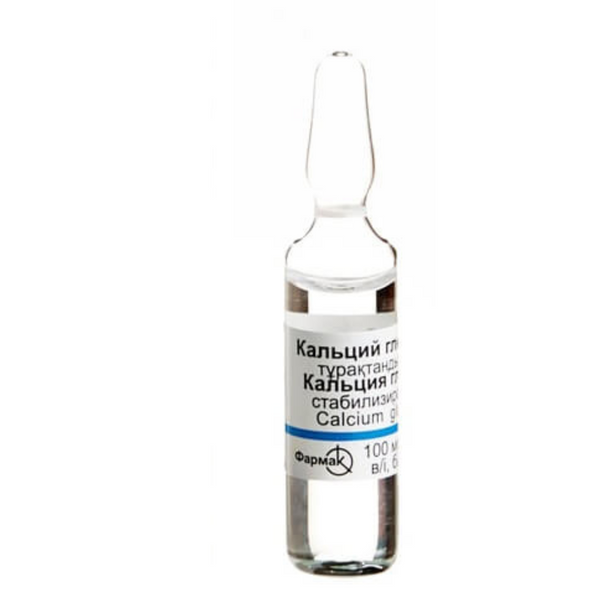|
Quantity
|
Out of stock
|
||
|
|
|||
Composition
Active ingredient: calcium gluconate 1 ml calcium gluconate 85 mg, calcium levulinate 10 mg
Excipients: calcium saccharate, diluted hydrochloric acid, water for injection.
1 ml of the drug contains 9.706 mg of total calcium (Ca 2+ ), which, in terms of the theoretical content of calcium gluconate, is equivalent to 100 mg / ml.
Dosage form
Injection solution.
Pharmacological group
Calcium preparations. ATC code A12A A03.
Indications
Insufficiency of the parathyroid glands; Increased excretion of calcium from the body (particularly with prolonged dehydration); As an adjuvant in allergic diseases (serum sickness, urticaria, angioedema) and allergic complications of drug therapy; To reduce vascular permeability in pathological processes of any genesis (exudative phase of the inflammatory process, hemorrhagic vasculitis, radiation sickness); Parenchymatous hepatitis; Toxic liver damage; Nephritis; Eclampsia; Hyperkalemia; Hyperkalemic form of paroxysmal myoplegia; Skin diseases (itching, eczema, psoriasis); As a hemostatic agent; As an antidote for poisoning with magnesium salts, oxalic acid or its soluble salts, soluble salts of fluoride.
Contraindications
Hypersensitivity to the components of the drug, tendency to thrombosis, hypercalcemia, severe hypercalciuria, severe atherosclerosis, increased blood clotting, severe renal failure, sarcoidosis, concomitant use with cardiac glycosides, ceftriaxone.
Method of administration and dosage
Administer intravenously or intramuscularly.
The ampoule with the solution is heated to body temperature before administration. The solution is administered slowly, over 2-3 minutes.
Adults and children over 14 years of age are administered 5-10 ml of "Calcium gluconate-Darnitsa (stabilized)" daily or every 1-2 days, depending on the course of the disease and the patient's condition.
For children, intravenously only, depending on age, 10% calcium gluconate solution is administered in the following doses: under 6 months - 0.1-1 ml, 6-12 months - 1-1.5 ml, 1-3 years - 1.5-2 ml, 4-6 years - 2-2.5 ml, 7-14 years - 3-5 ml.
To administer a solution in an amount of less than 1 ml, a single dose is brought to the appropriate volume (syringe volume) with 0.9% sodium chloride solution or 5% glucose solution.
Side effects
With rapid administration, nausea, vomiting, sweating, a feeling of heaviness in the head, syncope, general weakness, arterial hypotension, vasomotor collapse, sometimes fatal, are possible. Sometimes diarrhea, bradycardia, a feeling of heat in the mouth, and then in the whole body, which quickly pass on their own calcification of soft tissues due to extravasation of the calcium solution. Intramuscular injections of calcium salts can cause local irritation.
Allergic and anaphylactic reactions, up to anaphylactic shock, are very rare.
Overdose
Symptoms: hypercalcemia may develop. Symptoms of hypercalcemia may include anorexia, nausea, vomiting, constipation, abdominal pain, muscle weakness, polydipsia, polyuria, mental disorders, nephrocalcinosis, nephrolithiasis, in severe cases - arrhythmia and coma.
Treatment: in case of minor overdose (calcium concentration in the blood serum - 2.6-2.9 mmol / l), the administration is stopped and other calcium-containing drugs are canceled. In case of severe overdose (serum calcium concentration is more than 2.9 mmol/l), calcitonin is administered parenterally at a dose of 5-10 IU/kg of body weight per day (diluted in 500 ml of 0.9% sodium chloride solution), intravenously by drip over 6 hours. Slow intravenous jet injection is possible 2-4 times a day. Non-thiazide diuretics are used to monitor the concentration of potassium and magnesium in the serum, if necessary, potassium and magnesium preparations are administered, cardiovascular function is monitored, beta-blockers are administered to prevent arrhythmias. If necessary, hemodialysis is performed.
Use during pregnancy and breastfeeding
Use of the drug during pregnancy and breastfeeding is possible taking into account the benefit to the mother / risk to the fetus (child) ratio.
Children
It is not recommended to administer the drug intramuscularly to children under 14 years of age due to the possibility of developing necrosis.
Features of use
Calcium salts should be used with caution in patients with impaired renal function, with heart disease.
When used in patients receiving cardiac glycosides and / or diuretics, as well as during long-term treatment (especially in children), it is necessary to monitor the concentration of calcium and creatinine in the blood. In case of an increase in their concentration, the dose of the drug should be reduced or temporarily discontinued.
With caution and with regular monitoring of the level of calcium excretion in the urine, it is prescribed to patients with moderate hypercalciuria exceeding 300 mg / day (7.5 mmol / day), mild renal dysfunction, a history of urolithiasis. If necessary,
reduce the dose of the drug or cancel it. Patients with a tendency to form stones in the urinary tract are recommended to increase the volume of fluid consumed during treatment.
Before filling the syringe with calcium gluconate solution, make sure that there is no ethyl alcohol in it, since calcium gluconate precipitates as a result of interaction with alcohol.
Ability to affect reaction rate when driving vehicles or other mechanisms
There is no data on the negative effect of the drug on the reaction rate when driving vehicles or working with other mechanisms.
Interaction with other drugs and other types of interactions
When ethyl alcohol interacts with calcium gluconate, the latter precipitates.
It is not recommended to prescribe together with other calcium preparations.
The introduction of calcium gluconate before and after taking verapamil reduces its hypotensive effect, but does not affect its antiarrhythmic effect.
Combination with thiazide diuretics may lead to the development of hypercalcemia.
When used simultaneously with quinidine, intraventricular conduction may slow down and quinidine toxicity may increase.
During treatment with cardiac glycosides, parenteral use of calcium gluconate is not recommended due to increased cardiotoxic effect.
Calcium gluconate eliminates the inhibition of neuromuscular transmission caused by the use of aminoglycoside antibiotics.
When used simultaneously with Phenigidin, calcium preparations reduce its effectiveness.
Pharmacological properties
Pharmacodynamics.
Calcium gluconate (stabilized) is a drug that regulates metabolic processes, replenishes calcium deficiency in the body, has a hemostatic, antiallergic effect and reduces capillary permeability.
Calcium ions participate in the transmission of nerve impulses, contraction of smooth and transverse muscles, myocardial function, blood clotting; they are necessary for the formation of bone tissue, the functioning of other systems and organs. The concentration of calcium ions in the blood decreases in many pathological processes; severe hypocalcemia contributes to the development of tetany. In addition to eliminating hypocalcemia, calcium compounds reduce vascular permeability, have an antiallergic, anti-inflammatory, and hemostatic effect.
Pharmacokinetics.
After parenteral administration, the drug is evenly distributed in all tissues and organs. In blood plasma, calcium is in an ionized state. It passes through the placental barrier and is excreted in breast milk. It is excreted from the body mainly by the kidneys.
Basic physicochemical properties
transparent, colorless liquid.
Incompatibility
Pharmaceutically incompatible with ethyl alcohol, carbonates, salicylates, sulfates, tartrate.
Shelf life
3 years.
Storage conditions
Keep out of reach of children in the original packaging at a temperature not exceeding 25 ° C. Do not freeze.
Packaging
5 ml per ampoule, 10 ampoules per box, 5 ampoules in a blister pack, 2 blister packs per pack, 10 ml per ampoule, 5 ampoules in a blister pack, 1 or 2 blister packs per pack.
Dispensing category
On prescription.
































